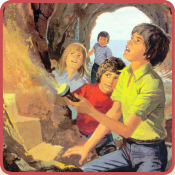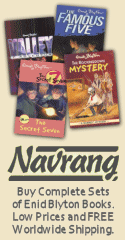
The Little Brown Bear

Book Details...
First edition: 1968
Publisher: Brockhampton Press
Illustrator: Jacques Fromont
Category: John and Mary
Genre: Family
Type: Short Story Books
Publisher: Brockhampton Press
Illustrator: Jacques Fromont
Category: John and Mary
Genre: Family
Type: Short Story Books
On This Page...
"Dear Santa Claus,
If you can manage it,
I should love to have a bear for Christmas.
With thanks and love from John."
If you can manage it,
I should love to have a bear for Christmas.
With thanks and love from John."
Mary's pretty confident she'll get what she wants for Christmas which is a doll, but John's trying harder in order to obtain his desire because in this particular case he's after a real live bear rather than just a Teddy! This is quite a tall order and hence the letter to Santa. There are laws in place to prevent people from owning potentially dangerous animals but John's philosophy is that if Father Christmas is the supplier, no one can say anything against it. His mother pours a little cold water on his proposal by saying,
"Santa knows I wouldn't like a real live bear in the house."
Good point, but John's still hoping he'll be successful, after all, one must hold positive thoughts throughout one's life.
Christmas arrives at last and there's a picture of Mary sitting by the tree nursing a doll. John's cavorting around in his new Red Indian suit so, what with that, the wigwam, and a toy car he's netted, all thoughts of live bears must have been forgotten for the time being.
Snow has fallen and the countryside is white as ... white as snow, which means that John and Mary leave their warm house next day to play around in the stuff and they can be seen outside with scarves round their necks, looking at some snowy footprints. In a previous story they had a dog called Pete who's actually referred to briefly in this tale because his prints can be recognized going back and forth through the front gate. That's reasonable enough, but the children happen to notice some extra marks crossing from a gap in the hedge and leading to the half-open door of their woodshed. Sherlock John observes that whatever went into the shed did not come out because there are no footprints to that end, so the shed is approached and John pushes the door open a little wider. To their amazement the children discover an animal hiding in some old sacks - none other than a little furry brown bear!
The children's surprise is tempered only by the fact that John had asked for a live bear and presumably it was delivered to the shed by Santa because he knew Mummy wouldn't like a bear in the house. So now that's all settled, the delighted children decide on a spur-of-the-moment name for their family addition - 'Grunty.' The picture shows him sitting between the children and looking up at John very expectantly.
Food!
That's it, and the kids race off to the house to see what they can find for their new pet.
"Mummy, what do bears eat?" asks Mary.
Now that's a giveaway if there ever was one, however their oblivious mother tells Mary that bruins go for buns and honey could also be placed fairly high on the list. As the larder is bereft of the former, Mummy suggests they have some bread and, presumably, she isn't in the kitchen when John cuts four enormous slices that Mary smothers liberally with honey. The kids fly off to re-join John's Christmas gift and watch intently as the bear consumes his repast before thrilling them both with a variety of antics.
John and Mary love their pet and spend so much time 'in the garden' as it were, that Mummy is quite surprised but she's also pleased because it's good for them to be out in the fresh air. The children visit Grunty regularly and John forks out sixpence each day on buns for the bear's pleasure. He also supplies Grunty with jars of honey and treacle because he simply loves sweet things.
Too good to last?
Right on! The children's secret is exposed when Mummy happens to visit the baker one day, and now the question arises as to whether or not John and Mary will be able to continue the excitement of fraternising with a real live Teddy bear.
This is John and Mary's 7th book.
I wonder how many children's bedrooms have chimneys these days. John's has, and that's where he placed his note to Santa.
Interesting how universal it is to fetch nourishment whenever an animal is discovered in one's space. There must be something comforting about food because the mad rush to supply sustenance occurs with humans as well; a friend is perhaps offered a cup of tea with a biscuit, and a dignitary's visit to another country requires at least a banquet.
The kids are back to using the terms 'Mummy' and 'Daddy' although Daddy doesn't make an appearance in this story. Pete neither!
As the children weren't up front with their mother about Grunty, they must have felt the bear didn't quite fit into the 'Christmas Present' category.
The bread and honey supplied to Grunty is pictured more as buns and honey.
John received half a dozen buns for each sixpence he spent.
There's a tendency to label bears as 'bruins.' The Department of 'Somewhat' Useless Information states that 'bruin' is Dutch for 'brown.'
The story is abridged from 'Enid Blyton's Bright Story Book' and Mary has been cut right out. It's 'Tony' who finds a bear in the garden shed, and the family have a dog called 'Don,' who's definitely anti-bear.
In 'The Christmas Book,' Enid Blyton reveals to us how the title of 'Santa Claus' came into being. Father Christmas himself informs Benny, Susan, Peter, and Ann that the Dutch called him San Nicolaas (St. Nicholas) and apparently the Americans started calling him Santa Claus. "Repeat San Nicolaas over and over again and see how easily it becomes Santa Claus." The children did so and found it to be quite true.
Once again we have an example of how the Enid Blyton books are broken up and spread all over the place; there are about four more pictures in the French version than in the Dutch one but can we get it right? The larger format Netherlands version is published by Sandle Brothers of London, and the French printing is produced by Brockhampton Press in Leicester! The case rests.








